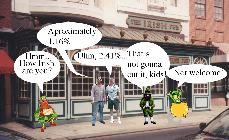St. Patrick’s Day is upon us again and already you can see the shelves of stores filling with novelty items consumers can’t resist purchasing to help them celebrate the upcoming holiday. If you ask the typical American why we celebrate St. Patrick’s Day, you’ll probably receive an answer involving green beer, thieving leprechauns, and hypothetical pots of gold that exist at the end of rainbows.
However, while the holiday may evoke a newfound pride of Irish heritage in even the unlikeliest of folk, like most of our holidays, it lost much of its original meaning in the Hallmark takeover of the 20th century. Once again we have forgotten the true reason that we commemorate the life of a historical figure, and have turned the holiday into another excuse to indulge in our three loves: drinking, eating and spending.
Historically, St. Patrick’s Day is the religious holiday that honors the life of Saint Patrick, the patron saint of Ireland. The day is celebrated on March 17, which is believed to be the traditional day of his ceremonial feasting and the date of his death. For 30 years, he spent his life guided by visions of God on a religious mission through Ireland to spread Christianity and convert the people from their traditional pagan beliefs.
Although the day originated as a religious holiday and remains a religious observance in Ireland, it became publicly recognized with the Irish Bank Holiday act of 1903.
Saint Patrick’s influence on Ireland as a nation was more than religious and he made his mark on the traditional Irish folklore that has been passed down for centuries.
Though there is some speculation as to the origin of many of the stories involving the saint, it is believed that his appreciation for the native Irish beliefs led to his incorporation of rituals and iconic symbols into his teachings of Christianity. He is responsible for the creation of what we now call the Celtic cross, which is what resulted from his superimposing of a sun onto a traditional Christian cross. He did this to incorporate the historically powerful Irish sun symbol into the transitioning religion.
He also contributed to the belief in the mystic powers of the clover, or shamrock, in Irish folklore. He believed that using the three leaves of the clover to represent the holy trinity was an effective way to maintain the nature-based beliefs of the native Irish within the Christian religion.
Today, however, little thought is given to the man behind the celebration or the reasons for which we sport the symbolic icons of the Irish traditions.
On St. Patrick’s Day, college parties and big city streets alike are transformed into gathering masses of drunken individuals doting green attire and stumbling out strange renditions of the Irish jig. During these festivities, Saint Patrick could more appropriately have been the original brewer of Guinness or the first man to single-handedly tap a keg. Mass production of holiday decorations fuel the revenue of many American stores during the month of March and alcohol sales rival those of April with spring break and January with the New Year.
While it was the original Irish colonialists that brought the holiday to America, St. Patrick’s Day has never been considered an official holiday here in the states. Still, it has been accepted as a day that we gather together as a nation to engage in the traditions of consumerism and over indulgence.
Everyone wants to be Irish on St. Patrick’s Day, and this is apparent in the way that so many seem to mysteriously recall the link to their Irish heritage during the middle of March. Non-conformists who refuse to wear green are pinched. Some cities like Boston dye their rivers green while others hold leprechaun led parades to mark the festivities. While all of these traditions may seem important to our culture as Americans, let’s not forget that this day is meant to remember the traditions of a nation and a religion that dates far back from the first man who dyed a beer green at his local pub. We celebrate to honor those Americans who take pride in their true Irish heritage and whose ancestors remember Saint Patrick as a man who had a tremendous influence on their culture and beliefs.
So this year, while wearing your “Kiss me, I’m Irish” pins and changing your last name from “Jones” to “McJonenassy” as you down a Guinness at your local Irish pub, don’t forget to throw one back for old Saint Patty. While we may have been able to once again taint a cultural and religious holiday with our love of indulgence, the least that can been done is a show of respect for someone worth commemorating, and a holiday that to some is more than just another reason to party.

